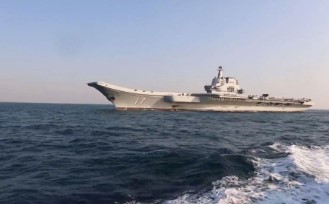On Tuesday, the Chinese military announced it had launched large-scale military drills around Taiwan, involving its army, navy, air force, and rocket forces. These exercises were described as a “stern warning” and a “forceful deterrence” against what China sees as Taiwan’s push for independence.
Military Power Drills Around Taiwan
The People’s Liberation Army (PLA) released a statement saying that the drills were designed to simulate attacks on maritime and ground targets. The military also practiced blocking key sea lanes to test the ability of their forces to work together in joint operations, showcasing China’s military power.
The drills took place near Taiwan, a self-governing island that China claims as its own. The Chinese military made it clear that the exercises were meant to showcase its military power and send a message about China’s determination to protect its territorial integrity.
The PLA’s Eastern Theater Command, which is responsible for operations in this area, also released a video showing military action, including Chinese frigates sailing, aircraft taking off, and missiles being prepared for launch, emphasizing China’s growing military power.
High-Stakes Standoff: Taiwan Blocks Suspicious Chinese Boat in Forbidden Waters
These drills serve as a display of China’s military power in the region and act as a reminder of the increasing tensions between China and Taiwan. The exercises were positioned as a direct response to Taiwan’s moves toward more independence and a clear warning to external powers like the United States, which has historically supported Taiwan’s defense.
Taiwan’s Response and Tensions
The drills were strongly condemned by Taiwan, which called them unnecessary and provocative. Taiwan’s National Security Council secretary-general, Joseph Wu, described the actions as “reckless” and a violation of international laws, urging democracies to speak out. Taiwan’s Defense Minister Wellington Koo said the island would closely monitor the situation, including the movements of China’s Shandong aircraft carrier. In response, Taiwan deployed its own aircraft, ships, and missile systems, showcasing its military power in the region.
China’s growing military presence near Taiwan is a major concern for the island, which has long been targeted by China’s territorial ambitions. Despite Taiwan’s status as a democracy, Beijing has repeatedly stated its intention to control Taiwan, even by force if needed. The current military exercises highlight China’s military power and its determination to prevent Taiwan’s independence.
The increasing display of military power near Taiwan underscores the growing tensions in the region, as China aims to strengthen its territorial claims. These military drills are a clear example of China’s military power at work, serving as both a warning to Taiwan and a message to the international community.
China’s Bold J-36 Test Sends Stealthy Warning to U.S. F-47 NGAD
The US and China’s Rising Rivalry
The timing of these military drills coincides with heightened tensions between China and the United States, especially concerning the Indo-Pacific region. Recently, US Defense Secretary Pete Hegseth visited Asia and strongly criticized China’s military actions, vowing to counter what he called “China’s aggression” in the region.
During his visit, he made it clear that the United States was focused on strengthening its military alliances in the Indo-Pacific, including with Taiwan’s neighbors like Japan and the Philippines, as a way to deter Chinese influence and aggression.
According to a report from the Taiwanese government, Hegseth’s statements were seen as a major factor behind the timing of China’s military exercises. The report suggested that Beijing’s actions were meant to respond to the US’s growing interest and involvement in the region.
The drills, though not explicitly named, are part of a pattern of increasing military activity by China around Taiwan, meant to showcase its strength and to send a signal to the US about its willingness to defend its territorial claims.
China has also ramped up regular patrols and military exercises around Taiwan, using these actions to test Taiwan’s defenses and to monitor how the island reacts to military pressure. In addition to the military drills, China’s coast guard launched “law-enforcement patrols” in the waters around Taiwan, simulating operations like the interception and detention of unwarranted vessels.
China’s Covert Surveillance in UK Universities Exposes Sinister Espionage Operations
These actions serve as another reminder of the growing military pressure on Taiwan, especially as China continues to assert its claims in the region.
China’s Broader Strategy
The military drills and increased patrols are part of China’s broader strategy under Xi Jinping to bring Taiwan under its control. Xi has used military force and intimidation to assert this goal.
Tensions have risen due to incidents like the detention of Chinese nationals in Taiwan for cutting undersea cables and Taiwan deporting a Chinese influencer advocating for a military takeover. These actions highlight China’s growing military power and its determination to assert dominance.
Taiwan Crisis Escalates as 2 U.S. Warships Challenge China in Strait
The Chinese military’s actions around Taiwan serve multiple purposes. They act as a direct challenge to Taiwan’s sovereignty, a message to the United States and its allies about the seriousness of China’s territorial claims, and a way for China to test its military readiness and military power in real-world scenarios.
With the US actively involved in the region, particularly under President Trump’s “America First” policy, China is keen to demonstrate its resolve and readiness to act if necessary, showcasing its growing military power in the Indo-Pacific.
Tensions between China and Taiwan have been rising for years, and Taiwan’s leaders have frequently called on the international community to stand against China’s growing military presence in the region. As the situation remains tense, Taiwan continues to rely on its military and international alliances, including support from the United States, to defend its sovereignty. The increasing demonstration of China’s military power only adds to the pressure Taiwan faces in safeguarding its independence.

